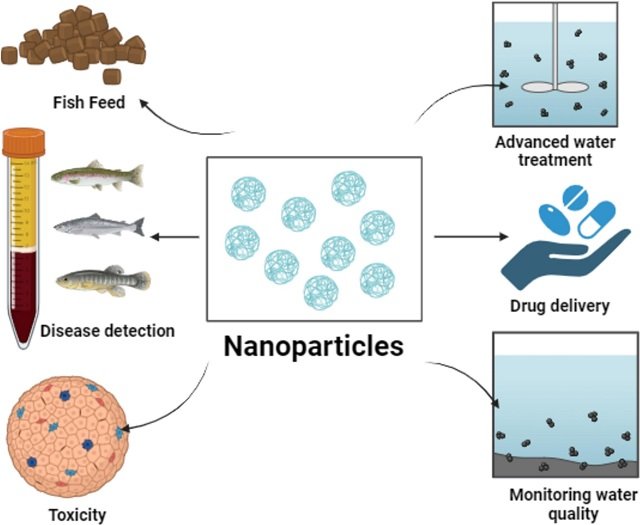
Shrimp aquaculture has experienced remarkable growth over the past two decades, significantly contributing to global food security and economic growth. However, the emergence of Acute Hepatopancreatic Necrosis Disease (AHPND) has cast a shadow over this success story. This devastating disease wreaks havoc on shrimp farms, causing immense economic losses, compromising animal welfare, and posing environmental threats.
A study published in the journal Aquaculture by scientists from Universiti Malaysia Terengganu explores the promising potential of metal nanoparticles (MNPs) as a revolutionary approach for both the treatment and diagnosis of AHPND.
The Challenge: AHPND and Its Devastating Impact
Shrimp aquaculture has seen significant growth over the past decades, contributing substantially to global food security and economic development. However, the emergence of AHPND, caused by the bacteria Vibrio parahaemolyticus, has overshadowed this success. AHPND wreaks havoc on shrimp farms, leading to:
- High mortality rates, often reaching 100% within a month.
- Significant economic losses for shrimp farmers.
- Compromised animal welfare due to the rapid and severe nature of the disease.
MNPs: A New Weapon Against AHPND
AHPND is caused by the bacteria Vibrio parahaemolyticus. Traditionally, antibiotics have been used to combat this pathogen. However, excessive use of antibiotics leads to antibiotic resistance, making them less effective. MNPs present a novel and potentially more sustainable approach.
- Antibacterial properties: Studies suggest that MNPs can effectively combat V. parahaemolyticus, offering a compelling alternative to antibiotic therapy.
- Environmental considerations: MNPs promise to be more environmentally friendly than antibiotics, potentially reducing the ecological footprint of shrimp aquaculture.
Metal Nanoparticles: A Versatile Tool
Nanotechnology, the manipulation of matter at the atomic and molecular scale, has gained attention in aquaculture. Metal nanoparticles (MNPs) are particularly promising due to their unique properties, including:
- Antimicrobial activity: MNPs can effectively kill bacteria, viruses, and fungi.
- Biocompatibility: Many MNPs are biocompatible, making them suitable for use in aquaculture.
- Enhanced drug delivery: MNPs can be used to deliver drugs and other agents to specific sites within the shrimp.
Addressing the Safety Challenge
While MNPs are highly promising, their potential integration into shrimp aquaculture faces a critical obstacle: toxicity. MNPs may have unintended consequences on shrimp health and the environment. Recognizing this challenge, researchers are focusing on developing biocompatible MNPs. These MNPs are specifically designed to be safe for shrimp and the aquaculture ecosystem.
Revolutionizing AHPND Diagnosis with MNPs
Early and accurate diagnosis is crucial for effectively managing AHPND. However, current diagnostic methods can be impractical for shrimp farmers due to their complexity. MNPs are being explored to create an easy-to-use diagnostic tool for detecting V. parahaemolyticus.
- Enhanced detection: MNPs have the potential to improve the sensitivity and specificity of AHPND diagnostic tests, leading to more accurate and reliable detection.
- User-friendly field approach: By incorporating MNPs, researchers aim to develop a user-friendly, on-site diagnostic kit that can be easily used by shrimp farmers, enabling rapid detection and early intervention.
The Future of Shrimp Aquaculture: A Brighter Horizon
The application of MNPs in the treatment and diagnosis of AHPND has the potential to revolutionize shrimp aquaculture. By harnessing the power of nanotechnology, we can envision a future where:
Stay Always Informed
Join our communities to instantly receive the most important news, reports, and analysis from the aquaculture industry.
- Effective and sustainable solutions combat AHPND, minimizing economic losses and safeguarding shrimp health.
- Biocompatible MNPs ensure the safety of shrimp and the environment.
- User-friendly diagnostic tools allow shrimp farmers to detect AHPND quickly and efficiently.
While the potential of nanoparticles in managing AHPND is promising, several challenges must be addressed:
- Toxicity: The toxicity of nanoparticles to shrimp and the environment must be carefully evaluated.
- Biocompatibility: Ensuring that nanoparticles are biocompatible and do not cause adverse effects is essential.
- Practical applications: Developing practical and cost-effective methods for using nanoparticles in aquaculture is crucial.
While further research and development are needed, MNPs offer a glimmer of hope for the shrimp aquaculture industry. By embracing innovative approaches like MNPs, we can strive for a more sustainable and secure future for shrimp production, ensuring a healthy and thriving industry that meets the growing global demand for shrimp.
The study was funded by the Ministry of Higher Education, Malaysia, under the Higher Institution Centre of Excellence (HICoE) grant, Institute of Tropical Aquaculture and Fisheries (AKUATROP).
Contact
Noor Aniza Harun
Advanced Nano Materials (ANOMA) Research Group, Faculty of Science and Marine Environment, Universiti Malaysia Terengganu
Kuala Nerus, 21030, Terengganu, Malaysia.
Email: nooraniza@umt.edu.my
Reference (open access)
Abu Hassan, M. S., Elias, N. A., Hassan, M., Mocktar, N. A., & Harun, N. A. (2025). Integrated overview on status, diagnosis and disease management of Acute Hepatopancreatic Necrosis Disease (AHPND) in shrimp aquaculture through metallic nanoparticles (MNPs) application – A review. Aquaculture, 595, 741649. https://doi.org/10.1016/j.aquaculture.2024.741649
Editor at the digital magazine AquaHoy. He holds a degree in Aquaculture Biology from the National University of Santa (UNS) and a Master’s degree in Science and Innovation Management from the Polytechnic University of Valencia, with postgraduate diplomas in Business Innovation and Innovation Management. He possesses extensive experience in the aquaculture and fisheries sector, having led the Fisheries Innovation Unit of the National Program for Innovation in Fisheries and Aquaculture (PNIPA). He has served as a senior consultant in technology watch, an innovation project formulator and advisor, and a lecturer at UNS. He is a member of the Peruvian College of Biologists and was recognized by the World Aquaculture Society (WAS) in 2016 for his contribution to aquaculture.



